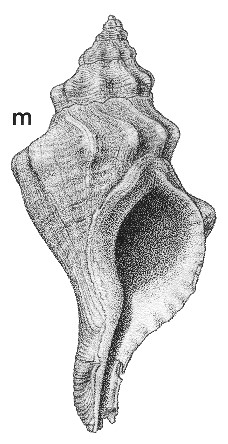
Revised descriptions of New Zealand Cenozoic Mollusca from Beu and Maxwell (1990)

 | Revised descriptions of New Zealand Cenozoic Mollusca from Beu and Maxwell (1990) | 
|
  (Pl. 20m): GS5177, J38/f9526, Tengawai River near Sutherlands, South Canterbury, Altonian (GNS) |
Beu & Maxwell (1990): Chapter 11; p. 197; pl. 20 m.
Synonymy: Verconella marwicki Finlay 1930b, p. 67-68
Classification: Buccinulidae
Description: Size moderate to large for genus (height typically 85-120 mm, but a few specimens up to 160 mm), solid, broadly fusiform, spire 0.3-0.4 total height. Protoconch tall, conical, of 3.5 strongly convex, smooth whorls. Teleoconch of 6-8 whorls, strongly convex at first then becoming bluntly but very prominently shouldered below middle, sutural ramp strongly concave, on most specimens extending up to just below periphery of previous whorl; last whorl weakly subangled on base, strongly excavated below with a long, curved neck. Axial sculpture commencing as heavy, rounded costae reaching from suture to suture, but soon becoming obsolete on ramp and forming very prominent, distant, rounded nodules on periphery; costae dying out on upper part of base of last whorl; 8-10 on penultimate whorl. Spiral sculpture most prominent on first 5 whorls or so, of numerous narrow, closely spaced cords, on most specimens broader, lower and less distinct on later whorls, last whorl typically with a noticeably stronger cord on basal subangulation, slightly thickened where it crosses lower ends of axial costae. Aperture large, ovate, columella concave above, twisted to left below to form long, open, weakly notched siphonal canal. Inner lip thickly callused in adult shells; outer lip weakly crenulate.
Comparison: Penion marwicki is distinguished from related species by its very strong, knob-like peripheral tubercles, which persist throughout growth, and its relatively subdued adult spiral sculpture. P. finlayi (Otaian, Bluecliffs, Otaio River and Tengawai River) is similar, but has a lower, more conic spire, more strongly clasping whorls (the sutural ramp extending up to the periphery of the previous whorl in most shells), and considerably stronger spiral sculpture, particularly on the base of the last whorl. The highly variable P. sulcatus (Pl. 49a) may be closely related to P. marwicki, but those forms with prominent, persistent peripheral nodules differ at sight from P. marwicki in having much stronger adult spiral sculpture.
Penion has a recorded range of Wangaloan (P. proavitus) to Recent in New Zealand, and although the genus has been recorded from Bortonian, Duntroonian and Waitakian rocks it was not until the Otaian or Altonian that it became relatively widespread and eventually, one of the most characteristic gastropod genera in the New Zealand Cenozoic. The genus is represented in the Australian fauna by five species, ranging in age from Early Miocene to Recent (Ponder 1973). Fossil species also occur in Oligocene-Miocene rocks of Chile and Argentina, and in Eocene rocks of Seymour Island, Antarctic Peninsula (Stilwell & Zinsmeister 1992, 128, pl. 17h-j). Hayashi (2005) reviewed the molecular phylogeny of the Buccinidae, and separated Penion from the similar, widespread, northern hemisphere genus Kelletia Fischer, 1884. He recorded other usages of Penion in the northern hemisphere, but considered them to be wrongly identified.
Distribution: Altonian; Mount Harris Formation, Mt Harris (type) and many other localities in North Otago and South Canterbury, most commonly in shallow-water sandstone or shellbeds.
Cite this publication as: "A.G. Beu and J.I. Raine (2009). Revised
descriptions of New Zealand Cenozoic Mollusca from Beu and Maxwell (1990). GNS
Science miscellaneous series no. 27."
© GNS Science, 2009
ISBN
978-0-478-19705-1
ISSN 1177-2441
(Included with a PDF facsimile file
copy of New Zealand Geological Survey Paleontological Bulletin 58 in CD version
from: Publications Officer, GNS Science, P.O. Box 30368 Lower Hutt, New
Zealand)